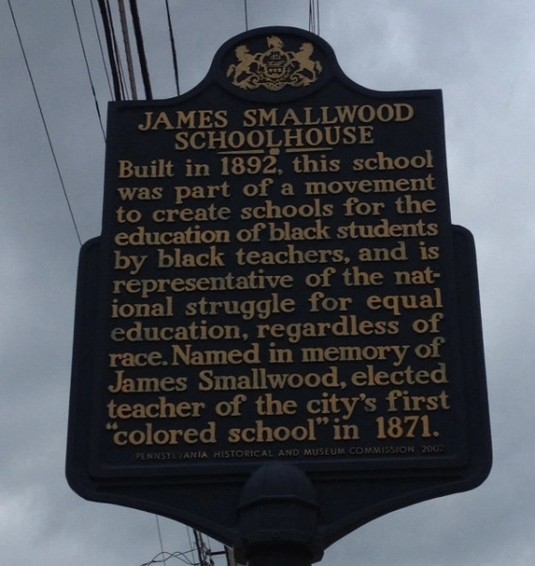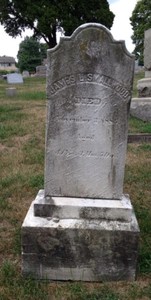James Smallwood Schoolhouse Historical Marker
Introduction
Text-to-speech Audio
Images
Historical Marker Inscription

James L Smallwood Grave

Marker with current building in background

James Smallwood at

Backstory and Context
Text-to-speech Audio
Back in the 1800s racism and slavery were rampant, and it was not just about the type of racism we see today, it was not allowing African Americans any sort of right. The right to get an education was something that many African Americans were not allowed to do. This was a problem and as many American's know the story of the civil war and ending slavery, there was a problem that still wasn't fixed. That being the fact that segregation was still allowed meaning, sure African Americans could get an education, if they can get someone to teach them. That lead to the idea of having separate schools where African American's teachers taught African American students.
James Smallwood was an African American born in Mulberry Ward, Philadelphia on July 28th, 1844. His parents Joseph Smallwood, who was a barber, and Lydia Smallwood was a homemaker. He also had three brothers and two sisters. James Smallwood graduated from the Institute for Colored Youth in 1864, and would become a teacher in 1867. By 1871 he would be elected as the teacher for the first African American school in York County, Pa. Smallwood would be a teacher until 1885, when he would die from paralysis. The James Smallwood Schoolhouse was built in 1892 in memory of him, as he was a major reason education was being given to African American children in York Pa. He was one of 2 African Americans to have a school named after them.
The schoolhouse was an elementary school for African American children. It had focused on a broad education to teach students basic skills like reading and writing along with basic mathematics. Unfortunately there isn't much more about the type of education that was taught at the schoolhouse other than it was a basic elementary school. It was in operation until 1954, whenever the Brown v. Board of Education Supreme Court case happened and had the desegregation of schools happen.
The schools built specifically for African American children were no longer useful after the Supreme Court delegation, the Smallwood schoolhouse would become essentially useless for many years. Eventually the building would become destroyed and the land would be used for other things. In 2002 they would erect a Historical Marker for the schoolhouse, since it was only one of the two African American schools in York PA.
Sources
1) Jkirk, Education and the uplift of our People, Published November 3rd 2017. Accessed May 18th 2021. http://yorkBlackhistory.com.
2) “James Smallwood Schoolhouse.” The Historical Marker Database, 16 June 2016, www.hmdb.org/m.asp?m=4598.
3) “James L. Smallwood (c. 1845-1885).” Falvey Memorial Library, exhibits.library.villanova.edu/institute-colored-youth/graduates/james-l-smallwood.
4) 14, posted September, et al. “The Institute for Colored Youth Project: Discovering the Life and Career of James L. Smallwood.” Historically Speaking, 15 Sept. 2014, vugradhistory.wordpress.com/2014/09/13/the-institute-for-colored-youth-project-discovering-the-life-and-career-of-james-l-smallwood/.
5) History.com Editors, History.com Editors. “Segregation in the United States.” History.com, A&E Television Networks, 28 Nov. 2018, www.history.com/topics/Black-history/segregation-united-states.
Elizabeth Motich
Elizabeth Motich
Bill Pfingsten of Bel Air, Maryland
